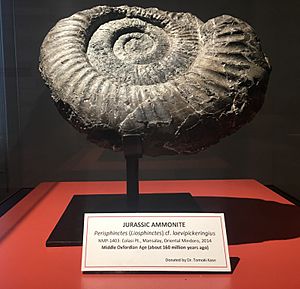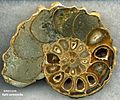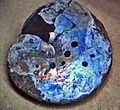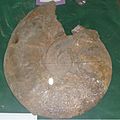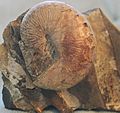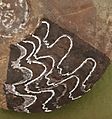Ammonite facts for kids
Quick facts for kids AmmonoiteTemporal range: Devonian – Cretaceous
|
|
|---|---|
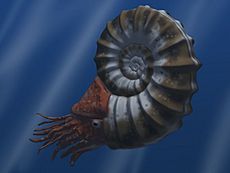 |
|
| Asteroceras | |
| Scientific classification | |
| Kingdom: | |
| Phylum: | |
| Class: | |
| Subclass: |
Ammonoidea
|
| Orders | |
|
Anarcestida; Clymeniida; Goniatitida; Prolecanitida; Ceratitida; Phylloceratida; Lytoceratida; Ammonitida; Ancyloceratina |
|
Ammonites were amazing sea creatures that lived long ago. They were a type of mollusc, like today's snails or clams. But ammonites were also cephalopods, which means they were related to octopuses, squids, and cuttlefish. Their closest living relative is the Nautilus.
These animals lived in the oceans for a very long time. They appeared about 400 million years ago and disappeared 65 million years ago. This was during the K/T extinction event, when the dinosaurs also died out.
Ammonites are famous for their spiral-shaped shells. These shells often look like a ram's horn. In fact, their name comes from the Egyptian god Ammon, who was often shown with ram's horns. The ancient Roman writer Pliny the Elder called their fossils ammonis cornua, meaning "horns of Ammon."
Scientists love finding ammonite fossils. This is because they are excellent "index fossils." This means they help scientists figure out the age of the rock layers where they are found.
How Ammonites Evolved
Ammonites first appeared in the early Devonian period. They evolved from an early type of Nautiloid. Over millions of years, they changed a lot. They developed many different shapes and sizes.
Ammonites faced several big challenges during their time on Earth. These were like major disasters that almost wiped them out.
- The first big event happened in the late Devonian period.
- Another one occurred at the end of the Permian period, about 250 million years ago.
- After these events, the few surviving ammonite species bounced back. They spread out and became very successful during the Triassic period.
- But at the end of the Triassic (206 million years ago), they almost vanished again. Only one species managed to survive!
This survival led them into the Jurassic period. During this time, the number of ammonite species grew again. However, the final disaster happened at the end of the Cretaceous period. This event wiped out all ammonite species, and they became extinct forever.
What Ammonites Looked Like
Ammonites started their lives as tiny creatures, less than 1 millimeter wide. When they were babies, they were easy prey for other animals. Their shells helped protect their soft bodies.
Young ammonites lived near the ocean surface, floating in the plankton. They ate small fish as they grew. This meant that anything bad happening to the plankton would also hurt the young ammonites.
Like most cephalopods, ammonites moved by jet propulsion. They would suck water into a special space called the mantle cavity. Then, they would squirt the water out quickly to push themselves forward.
Ammonite shells came in many different styles. Some were smooth, just like the modern Nautilus. Others had cool patterns of spiral ridges, ribs, or even spines. These fancy decorations were especially common in the later ammonites from the Cretaceous period.
Most ammonites from the early and middle Jurassic period were not very big. They were usually less than 23 centimeters (9 inches) across. But later, much larger ammonites appeared. For example, Titanites from England could be 53 centimeters (2 feet) wide.
One of the biggest known ammonites was Parapuzosia seppenradensis. This giant from the Cretaceous period in Germany could reach 2 meters (6.5 feet) in diameter! The largest one found in North America was Parapuzosia bradyi, which measured 137 centimeters (4.5 feet) across.
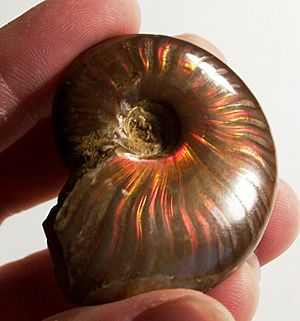
Some ammonite fossils, like those from Madagascar and Alberta (Canada), show beautiful iridescence. This means they shimmer with rainbow colors. These iridescent ammonites are often polished and used as gems, called ammolite. However, the living ammonites would not have shown these colors. Extra shell layers covered them.
Even though ammonites survived many major extinction events, they eventually disappeared. They became less common towards the end of the Mesozoic Era. None of them survived into the Cenozoic Era. The last ammonites died out with the dinosaurs 65 million years ago.
Images for kids
-
Iridescent ancient ammonite fossil on display at the American Museum of Natural History, New York City, around 2.5 feet in diameter
-
Fossil shell of ammonite Placenticeras whitfieldi showing punctures caused by the bite of a mosasaur, Peabody Museum of Natural History, Yale
-
A variety of ammonite forms, from Ernst Haeckel's 1904 Kunstformen der Natur (Art Forms of Nature)
-
Baculites ammonite from the Late Cretaceous of Wyoming, US: The original aragonite of the outer conch and inner septa has dissolved away, leaving this articulated internal mold.
-
A drawing of an aptychus which was mistakenly described as a bivalve and given the name "Trigonellites latus", from the Kimmeridge Clay Formation in England
-
Ammonoidea in Iran
-
A specimen of Hoploscaphites from the Pierre Shale of South Dakota, US: Much of the original shell, including the nacre, has survived.
-
Goniatites plebeiformis showing Goniatitic suture
See Also
 In Spanish: Ammonites para niños
In Spanish: Ammonites para niños


